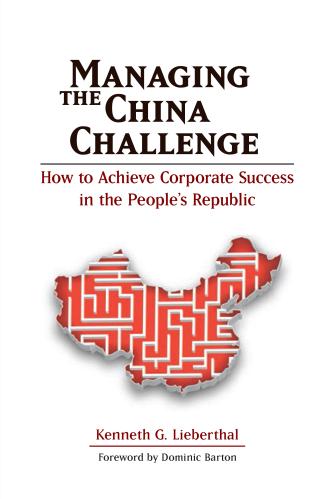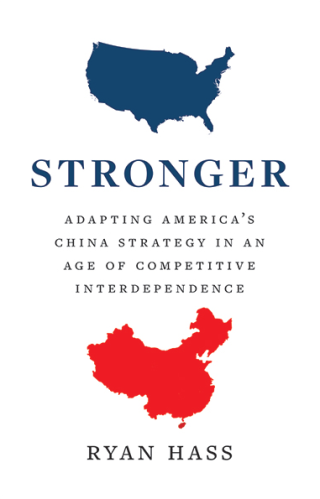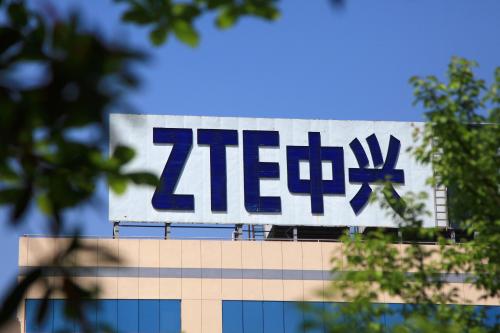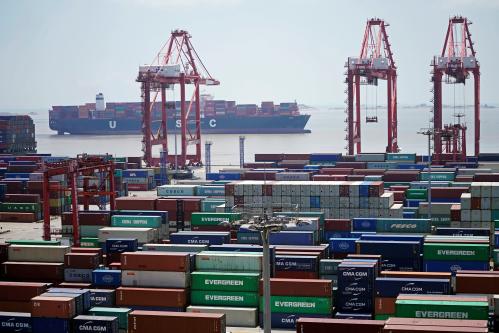If finalized along the lines that have been recently reported, the deal with Chinese company ZTE would remove a thorn from the U.S.-China relationship at a crucial time, writes David Dollar. This piece originally appeared in The Hill.
Press reports indicate that the Chinese telecom giant ZTE has reached an agreement in principle with the Commerce Department that would allow it to resume operations. The deal involves paying an additional $1 billion fine and putting $400 million into escrow as insurance against future fines.
As part of the deal, ZTE reportedly promised to replace its board and executive team in 30 days. It would also allow unfettered site visits to verify that U.S. components are being used as claimed by the company, and post calculations of U.S. parts in its products on a public website.
If finalized along these lines, the deal would remove a thorn from the U.S.-China relationship at a crucial time when final decisions are being made about tariffs against Chinese products and preparations are advancing for a summit between President Trump and North Korean dictator Kim Jong-un in Singapore next Tuesday.
It is an unfortunate precedent to alter what was basically a legal/regulatory ruling. But the initial sanction to prevent ZTE from buying U.S. components for seven years was essentially the death penalty.
It is unlikely that the Trump administration actually considered at a high level what this would do to U.S.-China relations. Given that initial mistake, it is a good thing that a severe penalty short of closing the firm has been agreed.
There has been bipartisan criticism in Congress, notably from Senators Marco Rubio (R-Fla.) and Chuck Schumer (D-N.Y.), about the renegotiation of the initial legal/regulatory judgment on ZTE. The company had violated U.S. sanctions by selling products to Iran and North Korea that contained U.S. parts and technology.
It had accepted a fine and agreed to make management changes. But then it did not follow through on the latter provisions. The Commerce Department decision that it could not buy U.S. components for seven years, however, was essentially the death penalty for a firm with more than 70,000 employees producing 55 million phones per year.
All of these ZTE products use imported American components, which was why the sanction led the firm to cease operating. In the current environment, it is costless for members of Congress to speak out against China and to advocate for the harsher measures.
It seems very unlikely, however, that Congress would actually move to undo the ZTE deal as it is part of a more complex negotiation with China that involves trade and investment as well as diplomacy with North Korea.
The ZTE deal has to be seen in the larger context of U.S.-China trade issues. Wednesday morning, the U.S. reported updated trade data through April. U.S. exports are growing well—9 percent year-on-year overall; 8 percent to China; and 8 percent to the eurozone. This reflects stronger growth in the world economy.
But U.S. imports are also rising rapidly as a result of late-cycle stimulus through the tax cuts. Imports year-on-year for January-April were up 9 percent overall; 11 percent from China; and 15 percent from the eurozone.
What this adds up to is a widening deficit overall (up 10 percent) and with key partners (China, up 12 percent; eurozone, up a whopping 27 percent). If these trends continue, the overall deficit for the year will be significantly larger, and the bilateral deficit with China will be up $44 billion.
This is the underlying trend that the United States is trying to fight in its talks with the Chinese. Press reports suggest that Secretary of Commerce Wilbur Ross came back from Beijing, not only with the ZTE deal, but also with an offer from the Chinese side to buy more American products, especially in agriculture and energy.
Different press accounts have various numbers, ranging from $100 billion in extra purchases this year to $70 billion to $25 billion. The $100-billion figure seems way too high for a partial year and is likely to be a multi-year offer; the $25 billion number is the most realistic for the remainder of the year.
Such a deal would lean against the trend noted above but not reverse it. It is very likely that by the end of the year, the bilateral trade deficit with China will hit a new historic high.
The Chinese have made clear that additional purchases are contingent on the U.S. not imposing the first round of 301 tariffs: 25 percent on $50 billion of imports from China. It is also clear that if the U.S. imposes tariffs, China will retaliate with tariffs on $50 billion of U.S. exports.
These measures will hurt both economies. The administration has an important decision to make soon on whether to follow through with the tariffs or take the deal offered by the Chinese.








Commentary
Trump throws ZTE a lifeline as part of broader China strategy
June 7, 2018